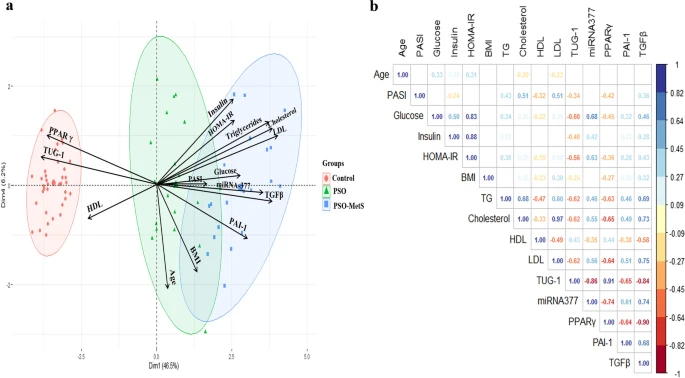

Long noncoding RNA (taurine upregulated gene 1) and micro RNA-377: emerging players in the development of metabolic syndrome among psoriasis patients
Background: Psoriasis (PsO) is an immune-mediated dermatosis and systemic inflammatory condition that can affect the skin, joints, and other organs and tissues with a range of comorbidities. The activation of proinflammatory cytokines is the primary cause of the development of skin lesions in PsO. Patients with PsO have a higher risk of developing cardiovascular metabolic comorbidities; among these is the metabolic syndrome (MetS). Particularly, MetS is characterized by abdominal obesity, hypertension, hyperglycemia, and hyperlipidemia, has been linked to PsO. The connection between PsO and MetS is believed to be caused by PsO generating systemic inflammation, which then results in elevated inflammatory adipokines, endothelial dysfunction, and insulin resistance. Micro RNA-377 and long noncoding RNA taurine upregulated 1 (TUG1) are both involved in the control of a variety of inflammatory disorders in humans and can be employed as biomarkers for the diagnosis and prognosis of psoriasis. The aim of the present study is to establish a panel of biomarkers for the early diagnosis of MetS incidence in psoriasis and thereby, reducing its lethal consequences. Results: In this study, 120 patients: 40 psoriatic patients, 40 psoriatic patients with metabolic syndrome, and 40 healthy subjects were conducted. Expressions of Long noncoding RNA Taurine Upregulated Gene-1 (TUG1), miRNA-377 and Peroxisome Proliferator-Activated Receptor-γ (PPAR-γ) were assessed in tissue lesion by real-time PCR. ELISA technique was carried out for the detection of serum levels of plasminogen activator inhibitor-1 (PAI-1) and transforming growth factor β (TGFβ). Moreover, miRNA-377 expression was significantly elevated with the simultaneous down-regulation of both TUG-1 and PPAR-γ in PsO-MetS group when compared to those of PsO and control groups. Furthermore, PAI-1 and TGFβ levels were higher in PsO-MetS than PsO. Conclusions: The dysregulated levels of TUG-1, miRNA-377, PPAR-γ, PAI-1, and TGFβ, biomarkers may provide information about their potential role in the emergence of MetS in psoriasis patients.